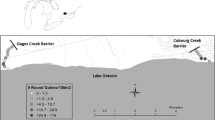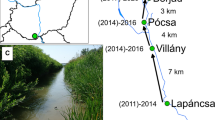Abstract
The red swamp crayfish (Procambarus clarkii) is a widespread invader which can disperse overland. This study was conducted to determine which factors can induce overland dispersal. During 12 months, the numbers of P. clarkii out of water were monitored at an experimental rice research station. Data were obtained on preferential time period for overland dispersal; population structure on land and in water; direction of movement; and the relation between environmental variables and the occurrence of crayfish out of water. A main factor inducing overland dispersal was intentional drainage of the study area associated with rice cultivation. During post-drainage, crayfish dispersal overland was positively correlated with rainfall. Other variables significantly affecting the overland dispersal of crayfish were the relative humidity, air temperature and the period of the day. We found significant differences in the structure of the trappable population in the water and of the individuals out of the water, with a higher proportion of mature individuals dispersing overland. Because overland migrants were dominated by mature individuals, often with eggs or hatchlings attached to the abdomen, these may effectively colonize new areas.







Similar content being viewed by others
References
Acosta, C. A. & S. A. Perry, 2001. Impact of hydropattern disturbance on crayfish population dynamics in the seasonal wetlands of Everglades National Park, USA. Aquatic Conservation: Marine and Freshwater Ecosystems 11: 45–57.
Anastácio, P. M. & J. C. Marques, 1998. Crayfish (Procambarus clarkii) condition throughout the year in the lower Mondego River valley, Portugal. Crustaceana 71: 593–602.
Anastácio, P. M., A. S. Leitão, M. J. Boavida & A. M. Correia, 2009. Population dynamics of the invasive crayfish (Procambarus clarkii Girard, 1852) at two marshes with differing hydroperiods. Annales de Limnologie – International Journal of Limnology 45: 247–256.
Aquiloni, L., M. Ilheu & F. Gherardi, 2005. Habitat use and dispersal of the invasive crayfish Procambarus clarkii in ephemeral water bodies of Portugal. Marine and Freshwater Behaviour and Physiology 38: 225–236.
Beja, P., 1996a. Seasonal breeding and food resources of otters, Lutra lutra (Carnivora, Mustelidae), in south-west Portugal: a comparison between coastal and inland habitats. Mammalia 60: 27–34.
Beja, P. R., 1996b. An analysis of otter Lutra lutra predation on introduced American crayfish Procambarus clarkii in Iberian streams. Journal of Applied Ecology 33: 1156–1170.
Breiman, L., J. H. Friedman, R. A. Olshen & C. J. Stone, 1984. Classification and Regression Trees. Wadsworth & Brooks/Cole Advanced Books & Software, Monterey.
Capinha, C. & P. Anastácio, 2011. Assessing the environmental requirements of invaders using ensembles of distribution models. Diversity and Distributions 17: 13–24.
Capinha, C., B. Leung & P. Anastácio, 2011. Predicting worldwide invasiveness for four major problematic decapods: an evaluation of using different calibration sets. Ecography 34: 448–459.
Capinha, C., L. Brotons & P. Anastácio, 2013. Geographical variability in propagule pressure and climatic suitability explain the European distribution of two highly invasive crayfish. Journal of Biogeography 40: 548–558.
Chucholl, C., 2011. Disjunct distribution pattern of Procambarus clarkii (Crustacea, Decapoda, Astacida, Cambaridae) in an artificial lake system in Southwestern Germany. Aquatic Invasions 6: 109–113.
Correia, A. M., 1992. A note on the occurrence of white-eyed red swamp crayfish, Procambarus clarkii (Decapoda: cambaridae) in portugal. Arquivos do Museu Bocage, Nova série II: 257–261.
Correia, A. M., 1995. Population dynamics of Procambarus clarkii (Crustacea: decapoda) in Portugal. Freshwater Crayfish 8: 276–290.
Cruz, M. J. & R. Rebelo, 2007. Colonization of freshwater habitats by an introduced crayfish, Procambarus clarkii, in Southwest Iberian Peninsula. Hydrobiologia 575: 191–201.
Daisie, 2010. One hundred of the worst – European invasive alien species gateway. http://www.europe-aliens.org/speciesTheWorst.do. Accessed 18 June 2011.
de la Bretone, L. & J. W. Avault, 1977. Egg development and management of Procambarus clarkii in a south Louisiana crayfish pond. Freshwater Crayfish 3: 133–140.
Dorn, N. J., R. Urgelles & J. C. Trexler, 2005. Evaluating active and passive sampling methods to quantify crayfish density in a freshwater wetland. Journal of the North American Benthological Society 24: 346–356.
Dorr, A. J. M., G. La Porta, G. Pedicillo & M. Lorenzoni, 2006. Biology of Procambarus clarkii (Girard, 1852) in lake Trasimeno. Bulletin Francais de la Peche et de la Pisciculture 380–381: 1155–1170.
European_Commission, 2011. Our Life Insurance, Our Natural Capital: An Eu Biodiversity Strategy to 2020 COM, Vol. 244. EC, Brussels.
Gherardi, F., 2002. Behaviour. In Holdich, D. (ed.), Biology of Freshwater Crayfish. Blackwell Science, Oxford: 258–290.
Gherardi, F., 2006. Crayfish invading Europe: the case study of Procambarus clarkii. Marine and Freshwater Behaviour and Physiology 39: 175–191.
Gherardi, F. & S. Barbaresi, 2000. Invasive crayfish: activity patterns of Procambarus clarkii in the rice fields of the lower Guadalquivir (Spain). Archiv für Hydrobiologie 150: 153–168.
Gherardi, F. G. & D. M. Holdich, 1999. Crayfish in Europe as Alien Species: How to Make the Best of a Bad Situation?, Vol. 11. CRC Press, London.
Gherardi, F., S. Barbaresi & G. Salvi, 2000. Spatial and temporal patterns in the movement of Procambarus clarkii, an invasive crayfish. Aquatic Sciences 62: 179–193.
Guerra, L. J. & A. E. Niño, 1995. Ecology of red swamp crayfish (Procambarus clarkii Girard) in the central meseta of Spain. Freshwater Crayfish 8: 179–200.
Hazlett, B., D. Rittschof & C. Ameyaw-Akumfi, 1979. Factors affecting the daily movements of the crayfish Orconectes virilis (Hagen, 1870)(Decapoda, Cambaridae). Crustaceana Supplement 5: 121–130.
Holdich, D. M., 2002. Biology of Freshwater Crayfish. Blackwell Science, Oxford.
Huner, J. V. & J. W. Avault, 1979. Introductions of Procambarus spp. Freshwater Crayfish 4: 191–194.
Huner, J. V. & J. E. Barr, 1991. Red Swamp Crawfish: Biology and Exploitation, Vol. 3. Louisiana Sea Grant College Program, Baton Rouge.
Kerby, J. L., S. P. D. Riley, L. B. Kats & P. Wilson, 2005. Barriers and flow as limiting factors in the spread of an invasive crayfish (Procambarus clarkii) in southern California streams. Biological Conservation 126: 402–409.
Loh, W. Y., 2011. Classification and regression trees. Wiley Interdisciplinary Reviews: Data Mining and Knowledge Discovery 1: 14–23.
McClain, W. R., 2010. Spawning date and potential contribution to yield from winter-burrowing Procambarus clarkii in crawfish aquaculture ponds. Journal of Shellfish Research 29: 7–12.
Penn Jr, G. H., 1943. A Study of the life history of the Louisiana red-crawfish, Cambarus clarkii Girard. Ecology 24: 1–18.
Ramalho, R. O., W. R. McClain & P. M. Anastácio, 2010. An effective and simple method of temporarily marking crayfish. Freshwater Crayfish 17: 57–60.
Ramos, M. A. & T. M. Pereira, 1981. Um novo astacidae para a fauna portuguesa: Procambarus clarkii (Girard, 1952). Boletim do Instituto Nacional de Investigaçao das Pescas 6: 37–47.
Suko, T., 1953. Studies on the development of the crayfish. i. the development of secondary sex characters in appendages. Science Reports of the Saitama University 1B: 77–96.
Viosca Jr, P., 1939. Where to fish in Louisiana for crawfish. Louisiana Conservation Review 8: 17–19.
Acknowledgments
The project ‘DID– Dispersion of Invasive Decapoda’ was financed by the European Fund for Economic and Regional Development (FEDER) through the Program Operational Factors of Competitiveness (COMPETE) and National Funds through the Portuguese Foundation of Science and Technology (PTDC/BIA-BEC/105 182/2008, FCOMP 01 0124 FEDER 00 89 65). Ricardo Ramalho had a PhD grant (SFRH/BD/19373/2004) from the Portuguese Foundation of Science and Technology. Thanks are due to COTArroz—Centro Operacional do Arroz for the permission to develop this research in their experimental rice fields. We thank the anonymous reviewers of this paper for their constructive scientific comments and also for the decisive contribute to improve the English in the manuscript.
Author information
Authors and Affiliations
Corresponding author
Additional information
Guest editors: Sidinei M. Thomaz, Katya E. Kovalenko, John E. Havel & Lee B. Kats / Aquatic Invasive Species
Electronic supplementary material
Below is the link to the electronic supplementary material.
Rights and permissions
About this article
Cite this article
Ramalho, R.O., Anastácio, P.M. Factors inducing overland movement of invasive crayfish (Procambarus clarkii) in a ricefield habitat. Hydrobiologia 746, 135–146 (2015). https://doi.org/10.1007/s10750-014-2052-9
Received:
Revised:
Accepted:
Published:
Issue Date:
DOI: https://doi.org/10.1007/s10750-014-2052-9




